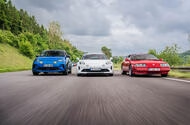When Luca de Meo took the helm at Renault Group in 2020, the future of Alpine, the brand’s premium sports car division, looked bleak. With no clear direction following the A110, many believed Alpine was on the chopping block. Fast forward to today, and de Meo has transformed Alpine into a key player in Renault’s strategy to reclaim its premium status. But how exactly does Alpine plan to rival established giants like Porsche? Let’s dive into the ambitious roadmap that aims to reshape this storied brand.
What’s the Game Plan for Alpine’s Revival?
De Meo recognized Alpine’s potential as a premium asset capable of boosting margins, much like his previous successes with Abarth and Cupra. His vision isn’t just about keeping the brand alive; it’s about revitalizing it. This revival includes expanding the lineup with new models like the A290, a sporty version of the Renault 5, and the A390, a powerful crossover based on the Renault Scenic. These additions signal a commitment to innovation and performance, but they also raise questions about the brand’s long-term viability in an increasingly competitive market.
Can Alpine Compete in the Electric Sports Car Arena?
The automotive landscape is shifting rapidly towards electric vehicles (EVs), and Alpine is diving headfirst into this transition. De Meo acknowledges the challenge of creating a credible rival to established brands like Porsche, emphasizing that building a premium brand takes time—at least 20 years, in his view. However, with limited resources, the journey won’t be easy. The U.S. market, a crucial battleground for premium brands, remains largely inaccessible for newcomers, forcing Alpine to rethink its strategy.
Alpine’s plans for larger electric SUVs have been put on hold, and while a single large SUV is still in the works, it hinges on a more favorable U.S. market. This cautious approach reflects the brand’s understanding of the current landscape, where competition is fierce, especially in markets like China, where local players are aggressively undercutting global brands.
How Is Alpine Building Its Brand Identity?
Currently, Alpine is primarily known in France, with two-thirds of its sales coming from its home country. To establish itself in the premium segment, the brand needs to expand its reach into markets like Germany, the UK, and Korea. The opening of its first ‘Atelier Alpine’ showcase store in Barcelona, followed by locations in Paris and London, marks a significant step in this direction.
Despite the challenges, Alpine has seen a surge in sales, doubling its numbers this year thanks to the A290. The A110, often referred to as the “Porsche 911 of Alpine,” has maintained interest among enthusiasts, but its future is uncertain as the brand prepares for an electric version expected to debut at the 2026 Paris Motor Show.
What Innovations Can We Expect from Alpine?
One of the most exciting aspects of Alpine’s future is its commitment to innovation. The brand plans to introduce the Alpine Performance Platform (APP), which promises to be lighter than traditional internal combustion engine (ICE) rivals. This platform will also feature in-wheel motors, a technology that could redefine handling and performance by allowing instantaneous power delivery to the wheels with the most grip.
Additionally, the APP will support an 800V electrical system for ultra-fast charging, addressing one of the major concerns of potential EV buyers: range anxiety. The first model to showcase this technology will be the Renault 5 Turbo 3E, an electric hyper-hatchback set to make waves in the market.
How Does Alpine Plan to Differentiate Itself?
Alpine is keen to position itself as a sporty premium brand that stands apart from luxury players. De Meo has emphasized that the brand is not merely an EV manufacturer; it’s about creating passionate, exclusive cars. This philosophy is rooted in Alpine’s 70-year heritage, which focused on doing more with less—a sentiment that resonates strongly in today’s automotive climate.
The brand aims to leverage its racing pedigree, with de Meo linking Alpine to its Formula 1 team and the World Endurance Championship. This connection not only enhances brand visibility but also underscores Alpine’s commitment to performance and innovation.
What’s Next for Alpine?
Looking ahead, Alpine has set ambitious goals, including a promise of 10% profit margins by 2030. With plans to operate as a standalone entity within the Renault group, the brand is gearing up for a potential stock market flotation in the future. However, the current appetite for automotive stocks is uncertain, and Renault will need to navigate these waters carefully.
Alpine’s journey is just beginning, and while the road ahead is fraught with challenges, the brand’s commitment to innovation, performance, and heritage could very well carve out a unique space in the premium automotive market.
The big takeaway? Building a premium brand isn’t about perfection—it’s about smarter adjustments. Start with one change this week, and you’ll likely spot the difference by month’s end.

